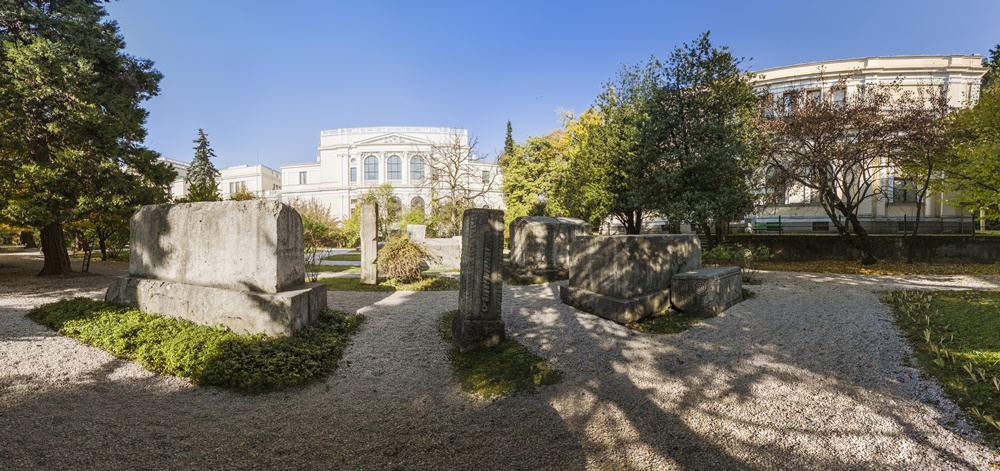Located in the heart of Sarajevo, the National Museum is a favorite tourist destination.

The National Museum of Bosnia and Herzegovina is located in Sarajevo, and it is the oldest museum in B&H, founded on February 1, 1888, during Austro-Hungarian rule. Once the space where the Museum was initially situated had become cramped and unsuitable, the construction of a new structure began in 1908. One of the most significant and prolific architects of the Austro-Hungarian period, Karel Parik, designed the building, which consists of four separate pavilions, interconnected by terraces, with an interior atrium, where the Botanical Garden is situated. This is the first museum building in Southeast Europe which was built for that specific purpose. The exterior of the Museum, as well as the space in front of it, which was enriched by stećci (medieval tombstones), leaves all passers-by on the main road in the city center in awe and admiration.
A RICH HERITAGE COLLECTION
If you visit the National Museum, you will have the opportunity to sail through the past through numerous exhibits. During its 131 years of existence, the Museum has managed to obtain a rich cultural and national heritage collection of the country and all its peoples. The exhibits are sorted by departments: the Archaeology Department, the Ethnology Department, the Department of Natural Sciences and the Conservation Department, in several different collections.
The archaeological collections follow all aspects of human life (settlements and dwellings, everyday life, economy, art, spirituality, religion etc.), in Bosnia and Herzegovina, from early Stone Age to the late Middle Ages. The collection items were mostly obtained through field work, and to a lesser extent through purchases and donations. Apart from museum activities, the experts here also do scientific research work.
If you were to try and single out the shiniest pearls from the treasury of material and immaterial cultural heritage that is kept at the Museum, you could not leave out the copy of the Passover Haggadah, the Jewish illuminated manuscript, known across the world as the Sarajevan Haggadah, which Sephardi Jews brought to Sarajevo once they were exiled from Spain. There are several Haggadahs across the world, and this one stands out due to its very rich illustrations, and the fact that its story begins from the creation of the world, while in the other Haggadahs the story begins with the salvation of Jews from Egypt.
The Sarajevan Haggadah was handwritten in Hebrew calligraphy on bleached calfskin, during a time when paper was still not in great use. This exceptional manuscript has a total of 142 parchment sheets, some of which are handwritten in calligraphy, some of which are illuminated, and some are completely empty. They were bound into parchments of eight and twelve pages. A little-known fact is that the Sarajevan Haggadah also has an appendix with songs, which is of great significance for Jewish literature in general.
AUTHENTIC ROOMS
The Ethnology Department collects, keeps, exhibits and studies all segments of material, spiritual and social culture of the peoples of B&H. It has a rich collection of museum material, which is stored and thematically classified into collections. The department has one permanent exhibition, which provides an insight into the residential culture and general culture of living of the wealthy urban population. Here, you will see scenes from everyday life, exhibited in six authentic rooms, which originate from the end of the 18th and the beginning of the 19th century. This department also offers several other thematic exhibitions each year.
When it comes to the number of collections, the largest department within the National Museum is the Department of Natural Sciences, which is made up of the Geology Department, Zoology Department and Botanical Department. It is estimated that there are around 2 million samples of minerals, rocks, fossils, plants, fungi and animals, collected mostly through field work. To a lesser extent, some were obtained through exchange, donations or through purchase.
Several years ago, the Conservation Department was formed at the Museum, and it deals with the restoration, conservation and protection of the cultural and natural heritage of B&H. The primary role of the Department is the protection of items from the collections of the National Museum of Bosnia and Herzegovina.
AN OASIS OF FRAGRANCES AND PRETTY COLORS
If you find yourself at the Museum, do not miss out on seeing the Library, which is organized as a special research library, with around 300 thousand volumes of publications (books, magazines, newspapers). This material was collected for over 100 years and relates to the fields of archaeology, history, ethnology, folklore, mineralogy, geology, botany, zoology and museology.
When you have seen all of the departments and the Library, you can have a rest in the central part of the Museum. Between the four buildings, there is a part that will simply thrill you, and it is especially pretty in spring when nature comes to life, turning it into an oasis of fragrances and pretty colors. The botanical garden, with its living collections, represents the only monument of this type in Sarajevo. It was founded in 1913, by Karlo Maly, a prominent botanist. The botanical garden has a very valuable herbarium, and it is home to many rare, endemic and exotic types of flora.
A lot more could be written about what the National Museum of Bosnia and Herzegovina has to offer, but in order to experience the magnitude and significance of this institution, and see the treasures it keeps, we recommend visiting the Museum.